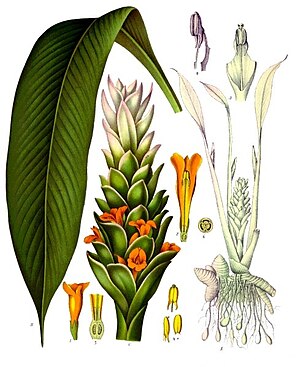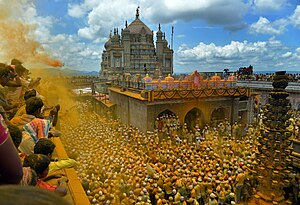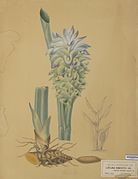Turmeric/ja: Difference between revisions
No edit summary |
|||
| (14 intermediate revisions by the same user not shown) | |||
| Line 13: | Line 13: | ||
}} | }} | ||
'''ターメリック'''({{IPAc-en|ˈ|t|ɜːr|m|ər|ɪ|k|,_|ˈ|tj|uː|-}}、学名:'''''Curcuma longa'''''({{IPAc-en|ˈ|k|ɜːr|k|j|ʊ|m|ə|_|ˈ|l|ɒ|ŋ|ɡ|ə}}))は、[[ginger/ja|ショウガ]]科[[Zingiberaceae/ja|ショウガ(Zingiberaceae)科]]の[[flowering plant/ja|顕花植物]]である。[[:en:Indian subcontinent|インド亜大陸]]および[[:en:Southeast Asia|東南アジア]]原産の[[perennial/ja|多年生]]の[[rhizomatous/ja|根茎性]][[herbaceous plant/ja|草本植物]] | '''ターメリック'''({{IPAc-en|ˈ|t|ɜːr|m|ər|ɪ|k|,_|ˈ|tj|uː|-}}、学名:'''''Curcuma longa'''''({{IPAc-en|ˈ|k|ɜːr|k|j|ʊ|m|ə|_|ˈ|l|ɒ|ŋ|ɡ|ə}}))は、[[ginger/ja|ショウガ]]科[[Zingiberaceae/ja|ショウガ(Zingiberaceae)科]]の[[flowering plant/ja|顕花植物]]である。[[:en:Indian subcontinent|インド亜大陸]]および[[:en:Southeast Asia|東南アジア]]原産の[[perennial/ja|多年生]]の[[rhizomatous/ja|根茎性]][[herbaceous plant/ja|草本植物]]で、生育には20℃から30℃の気温と高い[[:en:Annual rainfall in india|年間降水量]]を必要とします。毎年[[rhizome/ja|根茎]]を収穫し、一部は翌シーズンの繁殖用、一部は食用または[[:en:dye|染色]]用に用いられる。 | ||
根茎は生のままでも使用できるが、しばしば水で茹でて乾燥させた後、深みのあるオレンジ色の黄色い常温保存可能なスパイス粉末に粉砕される。これは多くの[[Asian cuisine/ja|アジア料理]]、特に[[Curry/ja|カレー]]([[curry powder/ja|カレー粉]])において、[[food coloring/ja#Natural food dyes|着色]]および風味付けの目的で一般的に使用されている。ターメリックパウダーは、温かく、苦く、[[black pepper/ja|黒胡椒]]のような風味と、土のような、[[mustard plant/ja|マスタード]]のような[[:en:aroma|香り]]を持つ。 | 根茎は生のままでも使用できるが、しばしば水で茹でて乾燥させた後、深みのあるオレンジ色の黄色い常温保存可能なスパイス粉末に粉砕される。これは多くの[[Asian cuisine/ja|アジア料理]]、特に[[Curry/ja|カレー]]([[curry powder/ja|カレー粉]])において、[[food coloring/ja#Natural food dyes|着色]]および風味付けの目的で一般的に使用されている。ターメリックパウダーは、温かく、苦く、[[black pepper/ja|黒胡椒]]のような風味と、土のような、[[mustard plant/ja|マスタード]]のような[[:en:aroma|香り]]を持つ。 | ||
| Line 76: | Line 76: | ||
ターメリックは[[food color/ja|食品着色料]]として使用が承認されており、コード[[E number/ja|E100]]が割り当てられている。[[:en:oleoresin|オレオレジン]]は油性製品に使用される。 | ターメリックは[[food color/ja|食品着色料]]として使用が承認されており、コード[[E number/ja|E100]]が割り当てられている。[[:en:oleoresin|オレオレジン]]は油性製品に使用される。 | ||
[[annatto/ja|アナトー]](E160b)と組み合わせて、ターメリックは多くの食品を着色するために使用されてきた。ターメリックは、一部の[[Mustard (condiment)/ja|マスタード]]、缶詰の鶏肉[[broth/ja|ブロス]]、その他の食品に黄色を与えるために使用されることがあり、しばしば[[saffron/ja|サフラン]]のより安価な代替品として使われる。 | |||
{{Gallery| align= center | {{Gallery| align= center | ||
| File:TurmericMyanmar2.jpg | | File:TurmericMyanmar2.jpg | ||
| | |熱湯で[[rhizome/ja|根茎]]を洗浄するターメリック | ||
| File:TurmericMyanmar3.jpg | | File:TurmericMyanmar3.jpg | ||
| | |ターメリックの根茎を乾燥させる | ||
| File:Turmeric-powder.jpg | | File:Turmeric-powder.jpg | ||
| | |ターメリックパウダー | ||
| File:ओल्या हळदीची भाजी.jpg | | File:ओल्या हळदीची भाजी.jpg | ||
| | |ターメリックを主成分の一つとする調理された野菜。「サプジー」と呼ばれるインド料理 | ||
| File:Ganghwang-bap.jpg | | File:Ganghwang-bap.jpg | ||
|'' | |''カンファン-[[bap (food)/ja|パプ]]''(ターメリックライス) | ||
| File:Steamed Goan rice and jaggery cakes.jpg | | File:Steamed Goan rice and jaggery cakes.jpg | ||
|''[[Patoleo]]'' – | |''[[Patoleo/ja|パトレオ]]'' – [[:en:Goan Catholic|ゴア・カトリック]]様式で調理されたココナッツとココナッツパームシュガーの餡が入った、ターメリックの葉で蒸した甘い[[rice cake/ja|ライスケーキ]] | ||
}} | }} | ||
===伝統的な利用法=== | |||
== | [[File:Khandoba temple Pune.jpg|thumb|[[:en:Jejuri|ジェジュリ]]にある[[:en:Khandoba|カンドバ]]の新しい寺院で、信者が互いにターメリックパウダー(''バンダラ'')を浴びせ合う様子]] | ||
[[File:Khandoba temple Pune.jpg|thumb|[[ | 2019年、[[:en:European Medicines Agency|欧州医薬品庁]]は、ターメリックのハーブティーやその他の経口摂取形態について、長年の伝統的な使用に基づき、満腹感や[[flatulence/ja|鼓腸]]などの軽度の消化器系の問題を緩和するために使用できると結論付けた。 | ||
ターメリックは南アジアと東南アジアの森林に自生しており、古典インド医学(シッダ医学またはアーユルヴェーダ)で使用するために採取されている。インド東部では、この植物は、若い[[plantain (cooking)/ja|プランテン]]またはバナナの植物、[[taro/ja|タロイモ]]の葉、[[barley/ja|大麦]]({{Transliteration|sa|jayanti}})、[[Aegle marmelos/ja|ウッドアップル]]({{Transliteration|sa|bilva}})、[[pomegranate/ja|ザクロ]]({{Transliteration|sa|darimba}})、''[[Saraca indica/ja|サラカ・インディカ]]''、{{Transliteration|sa|manaka}}(''[[Arum/ja|アラム]]'')、または{{Transliteration|sa|manakochu}}、そして水稲とともに、{{Transliteration|sa|nabapatrika}}の9つの構成要素の一つとして使用される。ベンガル地方で{{Transliteration|bn|[[:en:gaye holud|gaye holud]]}}(文字通り「体に黄色」)と呼ばれるハルディの儀式は、インド亜大陸全域のインド文化圏の人々の結婚式の祝い事で行われる儀式である。 | |||
[[:en:Tamil Nadu|タミル・ナードゥ州]]および[[:en:Andhra Pradesh|アーンドラ・プラデーシュ州]]では、タミル語とテルグ語の結婚儀式の一部として、紐で結ばれた乾燥ターメリックの塊が[[Thali necklace/ja|ターリ]]を作るために使用される。インド西部および沿岸部では、[[:en:Marathi people|マラーティー人]]と[[:en:Konkani people|コンカニ人]]、[[:en:Kannada people|カンナダ人]][[:en:Brahmins|バラモン]]の結婚式において、夫婦は儀式「''カンカナ・バンダナ''」の間、手首に紐でターメリックの塊を結びつける。多くのヒンドゥー教コミュニティでは、ハルディの儀式として知られる結婚式前の祝祭の一部として、ターメリックペーストが新郎新婦に塗られる。 | |||
ターメリックは[[:en:Colour fastness|耐光性]]がないため、生地の[[:en:dye|染料]]としては劣るが、[[:en:sari|サリー]]や[[:en:Kasaya (clothing)|仏教僧侶の衣]]など、インドの衣服には一般的に使用される。[[:en:Edo period|江戸時代]]後期(1603年〜1867年)には、より高価な[[safflower/ja|ベニバナ]]染料の代替または希釈剤として、[[:en:shibori#Beni itajime|紅板締め絞り]]の生産にターメリックが使用された。[[:en:Friedrich Ratzel|フリードリヒ・ラッツェル]]は1896年の『人類の歴史』で、ミクロネシアではターメリックパウダーが身体、衣服、道具、儀式用途の装飾に用いられていたと報告している。[[:en:Hawaii|ハワイ]]にターメリックを導入した[[:en:Native Hawaiians|ハワイ先住民]]({{langx|haw|{{okina}}ōlena}})は、それから鮮やかな黄色の染料を作る。 | |||
===指示薬=== | |||
[[File:TurmericAcidBase.jpg|thumb|水に分散したターメリックは、酸性条件下では黄色、アルカリ性条件下では赤色になる]] | |||
[[File:TurmericAcidBase.jpg|thumb| | ターメリック紙は、クルクマ紙とも呼ばれ、ドイツの文献では''Curcumapapier''と呼ばれる。ターメリックの[[tincture/ja|チンキ]]に浸して乾燥させた紙であり、[[chemical analysis/ja|化学分析]]において[[acidity/ja|酸性度]]と[[alkalinity/ja|アルカリ性度]]の[[pH indicator/ja|指示薬]]として使用される。この紙は酸性および[[neutral solution/ja|中性溶液]]では黄色であるが、アルカリ性溶液では褐色から赤褐色に変化し、pH7.4から9.2の間で変色する。 | ||
==混入{{Anchor|Adulteration}}== | |||
==Adulteration== | ターメリックや他の香辛料は一般的に重量で販売されるため、類似した色の有毒で安価な物質(例えば、[[lead(II,IV) oxide/ja|酸化鉛(II,IV)]](「赤鉛」))の粉末が混入される可能性がある。これらの添加物はターメリックに本来の黄金色ではなくオレンジレッドの色を与える。このような状況により、米国[[Food and Drug Administration/ja|食品医薬品局]](FDA)は2013年から2019年にかけて[[:en:India|インド]]と[[:en:Bangladesh|バングラデシュ]]産のターメリックに対し輸入警告を発した。2014年に米国に輸入されたターメリックは約{{convert|12|e6lb|e6kg|abbr=off|order=flip}}であり、その一部は[[food coloring/ja|食品着色料]]、[[traditional medicine/ja|伝統医学]]、または[[dietary supplement/ja|栄養補助食品]]として使用された。ターメリック製品から鉛が検出されたことにより、2016年まで米国、カナダ、日本、韓国、英国で[[:en:product recall|製品回収]]が行われた。 | ||
鮮やかな黄色の化学化合物である[[Lead chromate/ja|クロム酸鉛]]は、バングラデシュでターメリックの混入物として発見された。同国ではターメリックが食品に広く使用されており、汚染レベルは国家基準の最大500倍に達していた。研究者らは、ターメリックにクロム酸鉛を混入させる一連の供給源を特定した。それは、農家から低品質のターメリック根を販売する業者、「研磨業者」(黄色を強調するためにクロム酸鉛を加える)、そして市場流通のための[[:en:wholesale|卸売業者]]に及び、全員が鉛中毒の潜在的な結果を認識していなかった。 | |||
[[Lead chromate]] | |||
ターメリックのもう一つの一般的な混入物である[[metanil yellow/ja|メタノールイエロー]](酸性黄36としても知られる)は、[[:en:Great Britain|英国]][[:en:Food Standards Agency|食品基準庁]]によって食品への使用が違法な[[:en:dye|染料]]と見なされている。 | |||
==医学研究{{Anchor|Medical research}}== | |||
==Medical research== | {{see also/ja|Curcumin/ja|label 1=クルクミン}} | ||
{{see also|Curcumin|label 1= | |||
ターメリックとクルクミンは、様々なヒトの疾患や病態に対して数多くの[[clinical trial/ja|臨床試験]]で研究されてきたが、病気に対する効果や健康上の利点を示す質の高い証拠は得られていない。2020年現在、クルクミンが[[inflammation/ja|炎症]]を軽減するという科学的証拠はない。ターメリック抽出物が、膝の[[osteoarthritis/ja|変形性関節症]]の症状緩和や、運動後の痛みや筋肉損傷の軽減に有益である可能性があるという弱い証拠がある。ターメリックがアレルゲンであるという確かな証拠がある。 | |||
ターメリックは[[bioavailability/ja|生体利用効率]]が低いが、一部のサプリメントは様々な調製技術によって効力を高めている。ターメリックサプリメントは肝毒性があり、[[herb-induced liver injury/ja|ハーブ誘発性肝障害]]の発生率の増加が記録されている。イタリア政府は、ターメリックの健康上の利点に関するいかなる主張も禁止し、ターメリックベースのサプリメントに警告を義務付けている。 | |||
==関連項目== | ==関連項目== | ||
Latest revision as of 20:59, 9 June 2025
| Turmeric/ja | |
|---|---|

| |
| Curcuma longaの花序 | |

| |
| ターメリック根茎と粉末 | |
| Scientific classification | |
| Kingdom: | Plantae |
| Clade: | Tracheophytes |
| Clade: | Angiosperms |
| Clade: | Monocots |
| Clade: | Commelinids |
| Order: | Zingiberales |
| Family: | Zingiberaceae |
| Genus: | Curcuma |
| Species: | longa
|
| Binomial name | |
| longa | |
| Synonyms | |
|
Curcuma domestica Valeton | |
ターメリック(/ˈtɜːrmərɪk, ˈtjuː-/、学名:Curcuma longa(/ˈkɜːrkjʊmə ˈlɒŋɡə/))は、ショウガ科ショウガ(Zingiberaceae)科の顕花植物である。インド亜大陸および東南アジア原産の多年生の根茎性草本植物で、生育には20℃から30℃の気温と高い年間降水量を必要とします。毎年根茎を収穫し、一部は翌シーズンの繁殖用、一部は食用または染色用に用いられる。
根茎は生のままでも使用できるが、しばしば水で茹でて乾燥させた後、深みのあるオレンジ色の黄色い常温保存可能なスパイス粉末に粉砕される。これは多くのアジア料理、特にカレー(カレー粉)において、着色および風味付けの目的で一般的に使用されている。ターメリックパウダーは、温かく、苦く、黒胡椒のような風味と、土のような、マスタードのような香りを持つ。
古くからアーユルヴェーダ医学で利用されてきたが、ターメリックまたはターメリックの主要成分であるクルクミンの摂取が病気の治療に効果があるという質の高い臨床的証拠はない。ターメリック植物が生成する鮮やかな黄色の化学物質であるクルクミンは、世界保健機関、欧州議会、およびアメリカ食品医薬品局によって食品添加物として承認されている。ターメリックのサプリメントは、ハーブによる肝障害の増加の原因となっており、政府による規制の対象となっている。

起源と分布
クルクマ属の種数における最大の多様性はインドにあり、約40から45種を数える。タイも同程度の30から40種を有する。熱帯アジアの他の国々にも、クルクマ属の野生種が多数存在する。近年の研究では、C. longaの分類が問題であることが示されており、南インド産の標本のみがC. longaとして識別可能である。世界各地の他の種や栽培品種の系統発生、関係、種内・種間変異、さらには同定についても、依然として確立・検証が必要である。アジアの他の地域で現在「ターメリック」として利用・販売されている様々な種は、複数の物理的に類似した分類群に属することが示されており、現地名も重複している。
歴史
ターメリックはアジアで数世紀にわたり使用されており、アーユルヴェーダ、シッダ医学、伝統的な中国医学、ユナニ医学、そしてオーストロネシア人のアニミズム的儀式の主要な一部である。当初は染料として、その後民間療法におけるそのとされる特性のために使用された。
インドでは、黄色の染料が僧侶や司祭の衣を染めるのに使用されたため、ヒンドゥー教や仏教とともに広まった。
東南アジア島嶼部では、インドとの接触以前、台湾からの拡散(紀元前3000年頃から)後まもなく、オーストロネシア人の間でターメリックが古くから使用されていたことを示す言語学的および状況的証拠がある。インドネシアやフィリピンでは、ターメリックは食品、繊維の染色、医薬品、そして身体の彩色のために使用された。これは様々なアニミズム的儀式において一般的に重要な成分であった。KikusawaとReid(2007)は、オーストロネシア語における「ターメリック」の最も古い再構築された古マレー・ポリネシア語形である*kunijが、主に染料としての使用の重要性に関連していると結論付けている。東南アジア原産のクルクマ属の他のメンバー(Curcuma zedoariaなど)も食品やスパイスとして使用されたが、染料としては使用されなかった。
ターメリック(Curcuma zedoariaとともに)は、オーストロネシア人の拡大に伴い、ラピタ人によってオセアニアにも広まった。ターメリックは根茎でしか繁殖できないため、太平洋諸島への先ヨーロッパ接触以前の分布は、人間による導入のみによって説明できる。ミクロネシア、メラネシア島嶼部、ポリネシア(ハワイやイースター島を含む遠方まで)の住民は、ヨーロッパとの接触以前に、食品と染料の両方にターメリックを広く使用した。ミクロネシアでは、ヤップ島とカロリン諸島のさらに遠い環礁の間で行われた海上交易「sawei」において重要な交易品であった。そこではターメリックは育たなかった。一部の小さな島々では、根茎が砂質の土壌で小さすぎたため、葉から染料が抽出された。また、オーストロネシア人の移住によってマダガスカルにも運ばれた。
ターメリックは、紀元前2600年から2200年の間にさかのぼるファルマーナで発見され、紀元前2千年紀にさかのぼるイスラエルのメギドにある商人の墓でも発見された。紀元前7世紀のアッシュールバニパル図書館にあったアッシリア人の楔形文字医療文書に染料植物として記されている。中世ヨーロッパでは、ターメリックは「インドのサフラン」と呼ばれた。
語源
この名称は、中英語または初期近代英語のturmeryteまたはtarmaretに由来する可能性がある。ラテン語のterra merita(「価値ある土」)が語源かもしれない。ラテン語の種小名longaは「長い」を意味する。
特徴
ターメリックは、高さ約1 m (3 ft 3 in)に達する多年生の草本植物である。非常に枝分かれした、黄色からオレンジ色で円筒形の香りのよい根茎を持つ。
葉は互生で2列に配置される。葉鞘、葉柄、葉身に分かれる。葉鞘からは偽茎が形成される。葉柄は長さ50 to 115 cm (20–45 in)である。単純な葉身は通常長さ76 to 115 cm (30–45 in)で、稀に230 cm (7 ft 7 in)に達する。幅は38 to 45 cm (15 to 17 1⁄2 in)で、長楕円形から楕円形であり、先端に向かって狭くなる。
花序、花、果実
花序の頂部には花のない茎状の苞が存在し、これらは白から緑色で時に赤紫色を帯び、上端は先細りになっている。
両性花は左右対称で3数性である。3つの萼片は長さ0.8 to 1.2 cm (3⁄8 to 1⁄2 in)で、合着しており、白色で綿毛状の毛を持つ。3つの萼歯は不均等である。3つの鮮やかな黄色の花弁は、長さ最大3 cm (1 1⁄4 in)の花冠筒に合着する。3つの花冠裂片は長さ1.0 to 1.5 cm (3⁄8–5⁄8 in)で、三角形をしており、上端は柔らかい棘状である。中央の花冠裂片は両側の2つの裂片よりも大きいが、内側の輪の中央の雄しべのみが稔性である。葯は基部に距を持つ。他のすべての雄しべは仮雄しべに変化している。外側の仮雄しべは唇弁よりも短い。唇弁は黄みがかっており、中央に黄色の帯があり、長さ1.2 to 2.0 cm (1⁄2 to 3⁄4 in)の倒卵形である。3つの心皮は、まばらに毛が生えた癒着性の3裂子房の下にある。果実の蒴果は3つの区画に開裂する。
東アジアでは、開花時期は通常8月である。偽茎の先端には、長さ12 to 20 cm (4 1⁄2 to 8 in)で多くの花を含む花序茎がある。苞は淡い緑色で、鈍い上端を持つ卵形から長楕円形であり、長さは3 to 5 cm (1 to 2 in)である。
-
Curcuma domestica Valeton、1860年頃のA. ベルネッカーによるドローイング
-
デカン高原のターメリック畑
-
ターメリックの花
植物化学


ターメリック粉末は、約60〜70%が炭水化物、6〜13%が水分、6〜8%がタンパク質、5〜10%が脂肪、3〜7%がミネラル、3〜7%が精油、2〜7%が食物繊維、そして1〜6%がクルクミノイドで構成されている。ターメリックの黄金色はこのクルクミンによるものである。
植物化学的成分には、多数のクルクミノイド(クルクミン、デメトキシクルクミン、ビスデメトキシクルクミンなど)を含むジアリルヘプタノイド類がある。クルクミンは、市販のターメリック粉末の検査サンプルにおいて最大3.14%を占める(平均は1.51%)。カレー粉にははるかに少ない(平均0.29%)。ターメリックには約34種類の精油が存在し、その中でターメロン、ゲルマクロン、アトランストン、ジンギベレンが主要な構成成分である。
用途
料理での利用
ターメリックは多くのアジア料理において主要な材料の一つであり、料理にマスタードのような、土っぽい香りと、刺激的でわずかに苦い風味を与える。主に塩味の料理に使われるが、レバノンのお菓子「スフーフ」のような甘い料理にも使われる。インドでは、ターメリックの葉は特別な甘い料理「パトレオ」を作るのに使われる。これは、米粉とココナッツとジャガリーの混合物を葉の上に重ね、閉じて特別な調理器具(chondrõ)で蒸すものである。ほとんどのターメリックは、黄金色を出すために根茎の粉末の形で使われる。缶飲料、焼き菓子、乳製品、アイスクリーム、ヨーグルト、イエローケーキ、オレンジジュース、ビスケット、ポップコーン、シリアル、ソースなど、多くの製品に使われている。カレー粉の主要な材料でもある。通常は乾燥した粉末状で使われるが、ショウガのように生のまま使うこともできる。
ターメリックは南アジアや中東料理において広くスパイスとして使われている。様々なイラン料理の「コレシュ」のレシピは、油でキャラメル化したタマネギとターメリックから始まる。モロッコ料理のスパイスミックスラス・エル・ハヌートには通常ターメリックが含まれる。南アフリカでは、ターメリックは茹でた白米に黄金色を与えるために使われ、「geelrys」(イエローライス)として知られ、伝統的にボボティーと一緒に供される。ベトナム料理では、ターメリックパウダーはバインセオ、bánh khọt、ミー・クアンなどの特定の料理の色付けと風味増強に使われる。多くの料理、例えばアモックなどに使われるカンボジアの主要なカレーペースト「クルーン」には、通常生のターメリックが含まれる。インドネシアでは、ミナンまたはパダン料理のスマトラのカレーベース、例えばルンダン、サテ・パダン、その他多くの種類にターメリックの葉が使われる。フィリピンでは、ターメリックはクニン、サティ、そしてアドボの一部のバリエーションの調理に使われる。タイでは、新鮮なターメリックの根茎が多くの料理で広く使われ、特にタイ南部料理のイエローカレーやターメリックスープなどに使われる。ターメリックは、牛乳、しばしばココナッツミルクで作られる「ターメリックラテ」または「ゴールデンミルク」と呼ばれる温かい飲み物にも使われる。haldī dūdh(haldī [हलदी]はヒンディー語でターメリックを意味する)として知られるターメリックミルクドリンクは、伝統的なインドのレシピである。米国と英国で販売されている「ゴールデンミルク」として知られる飲み物は、非乳製品のミルクと甘味料を使用し、伝統的なレシピ(ギーを使用することもある)に従って黒胡椒を加えることもある。
ターメリックは食品着色料として使用が承認されており、コードE100が割り当てられている。オレオレジンは油性製品に使用される。
アナトー(E160b)と組み合わせて、ターメリックは多くの食品を着色するために使用されてきた。ターメリックは、一部のマスタード、缶詰の鶏肉ブロス、その他の食品に黄色を与えるために使用されることがあり、しばしばサフランのより安価な代替品として使われる。
伝統的な利用法

2019年、欧州医薬品庁は、ターメリックのハーブティーやその他の経口摂取形態について、長年の伝統的な使用に基づき、満腹感や鼓腸などの軽度の消化器系の問題を緩和するために使用できると結論付けた。
ターメリックは南アジアと東南アジアの森林に自生しており、古典インド医学(シッダ医学またはアーユルヴェーダ)で使用するために採取されている。インド東部では、この植物は、若いプランテンまたはバナナの植物、タロイモの葉、大麦(jayanti)、ウッドアップル(bilva)、ザクロ(darimba)、サラカ・インディカ、manaka(アラム)、またはmanakochu、そして水稲とともに、nabapatrikaの9つの構成要素の一つとして使用される。ベンガル地方でgaye holud(文字通り「体に黄色」)と呼ばれるハルディの儀式は、インド亜大陸全域のインド文化圏の人々の結婚式の祝い事で行われる儀式である。
タミル・ナードゥ州およびアーンドラ・プラデーシュ州では、タミル語とテルグ語の結婚儀式の一部として、紐で結ばれた乾燥ターメリックの塊がターリを作るために使用される。インド西部および沿岸部では、マラーティー人とコンカニ人、カンナダ人バラモンの結婚式において、夫婦は儀式「カンカナ・バンダナ」の間、手首に紐でターメリックの塊を結びつける。多くのヒンドゥー教コミュニティでは、ハルディの儀式として知られる結婚式前の祝祭の一部として、ターメリックペーストが新郎新婦に塗られる。
ターメリックは耐光性がないため、生地の染料としては劣るが、サリーや仏教僧侶の衣など、インドの衣服には一般的に使用される。江戸時代後期(1603年〜1867年)には、より高価なベニバナ染料の代替または希釈剤として、紅板締め絞りの生産にターメリックが使用された。フリードリヒ・ラッツェルは1896年の『人類の歴史』で、ミクロネシアではターメリックパウダーが身体、衣服、道具、儀式用途の装飾に用いられていたと報告している。ハワイにターメリックを導入したハワイ先住民(Hawaiian: ʻōlena)は、それから鮮やかな黄色の染料を作る。
指示薬

ターメリック紙は、クルクマ紙とも呼ばれ、ドイツの文献ではCurcumapapierと呼ばれる。ターメリックのチンキに浸して乾燥させた紙であり、化学分析において酸性度とアルカリ性度の指示薬として使用される。この紙は酸性および中性溶液では黄色であるが、アルカリ性溶液では褐色から赤褐色に変化し、pH7.4から9.2の間で変色する。
混入
ターメリックや他の香辛料は一般的に重量で販売されるため、類似した色の有毒で安価な物質(例えば、酸化鉛(II,IV)(「赤鉛」))の粉末が混入される可能性がある。これらの添加物はターメリックに本来の黄金色ではなくオレンジレッドの色を与える。このような状況により、米国食品医薬品局(FDA)は2013年から2019年にかけてインドとバングラデシュ産のターメリックに対し輸入警告を発した。2014年に米国に輸入されたターメリックは約5.4 million kilograms (12 million pounds)であり、その一部は食品着色料、伝統医学、または栄養補助食品として使用された。ターメリック製品から鉛が検出されたことにより、2016年まで米国、カナダ、日本、韓国、英国で製品回収が行われた。
鮮やかな黄色の化学化合物であるクロム酸鉛は、バングラデシュでターメリックの混入物として発見された。同国ではターメリックが食品に広く使用されており、汚染レベルは国家基準の最大500倍に達していた。研究者らは、ターメリックにクロム酸鉛を混入させる一連の供給源を特定した。それは、農家から低品質のターメリック根を販売する業者、「研磨業者」(黄色を強調するためにクロム酸鉛を加える)、そして市場流通のための卸売業者に及び、全員が鉛中毒の潜在的な結果を認識していなかった。
ターメリックのもう一つの一般的な混入物であるメタノールイエロー(酸性黄36としても知られる)は、英国食品基準庁によって食品への使用が違法な染料と見なされている。
医学研究
ターメリックとクルクミンは、様々なヒトの疾患や病態に対して数多くの臨床試験で研究されてきたが、病気に対する効果や健康上の利点を示す質の高い証拠は得られていない。2020年現在、クルクミンが炎症を軽減するという科学的証拠はない。ターメリック抽出物が、膝の変形性関節症の症状緩和や、運動後の痛みや筋肉損傷の軽減に有益である可能性があるという弱い証拠がある。ターメリックがアレルゲンであるという確かな証拠がある。
ターメリックは生体利用効率が低いが、一部のサプリメントは様々な調製技術によって効力を高めている。ターメリックサプリメントは肝毒性があり、ハーブ誘発性肝障害の発生率の増加が記録されている。イタリア政府は、ターメリックの健康上の利点に関するいかなる主張も禁止し、ターメリックベースのサプリメントに警告を義務付けている。
関連項目
外部リンク
 The dictionary definition of turmeric/ja at Wiktionary
The dictionary definition of turmeric/ja at Wiktionary [[wikibooks:Cookbook:Turmeric/ja |]] at the Wikibooks Cookbook subproject
[[wikibooks:Cookbook:Turmeric/ja |]] at the Wikibooks Cookbook subproject
| この記事は、クリエイティブ・コモンズ・表示・継承ライセンス3.0のもとで公表されたウィキペディアの項目Turmeric(24 May 2025, at 14:58編集記事参照)を翻訳して二次利用しています。 |








